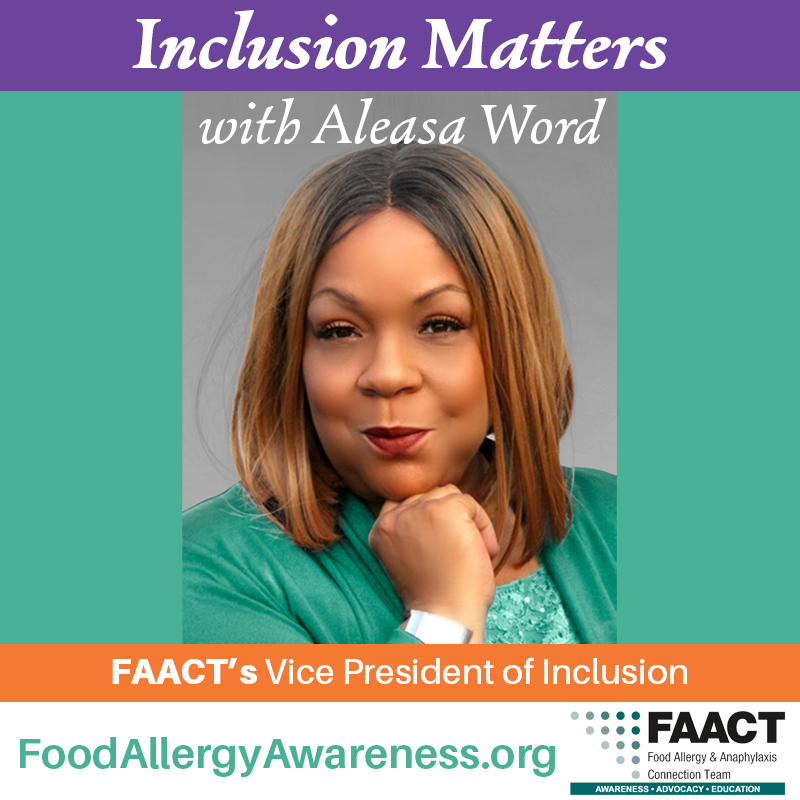Respect My Glasses: Experiencing Food Allergies Through Different Lenses
Subcategories

Respect My Glasses: Experiencing Food Allergies Through Different Lenses
by Aleasa Word, FAACT Vice President of Inclusion Initiatives
September 2025
According to the Vision Council, approximately 64% of adults in the United States wear eyeglasses. That’s a lot of people looking at the same world through a different lens. Some lenses sharpen focus while others reduce glare. Others might have a layered effect to help a person see better and remain safe. It shows us that the world may not change, but HOW we see it just might.
Living with food allergies is a lot like that. Each person wears their own unique set of “glasses” shaped by their diagnosis, environment, and daily living experiences. While one person might look at a menu and immediately scan for milk ingredients, another person might be focused on fish, peanuts, eggs, or any number of allergens. And people managing multiple allergens may feel like they’re wearing trifocals—constantly shifting their focus to catch risks from every angle.
The Milk Allergy Lens
For someone allergic to milk, a simple slice of pizza isn’t just dinner. It’s a series of questions: “Is the cheese alternative safe? What about the crust? Did they use butter on the pan? Was it prepared in a separate allergy friendly area?” Their “glasses” make them see risks others may never consider. To friends who don’t have food allergies, it may seem like they are overthinking a simple meal. Through a food allergy lens, however, they are protecting themselves from real danger.
The Egg Allergy Lens
Let’s put on another set of glasses. Breakfast and lunch buffets can look like obstacle courses filled with obvious—and hidden—dangers for people allergic to eggs. Pancakes, muffins, salad dressing, and serving utensils set off alarms. Social gatherings can feel less about connection and more about vigilance. This person’s lens sharpens their focus on hidden ingredients that don’t normally set off an alarm for people who don’t have food allergies.
The Trifocal Lens
Then there are people who manage multiple food allergies. Their glasses aren’t just tinted, they are layered. Their eyes must shift from one item to another, meticulously scanning as they refocus. They might have to worry about tree nuts in dessert, soy in sauces or gravy, and sesame seeds or powder in the buns. The mental load is heavy and the stakes are high. Respecting their experience means accepting their behaviors and not mistaking vigilance for being “extra” when it is paramount to their safety and well-being.
Respect Matters
The glasses metaphor reminds us that no two people are alike, nor are their experiences the same. Everything from the way a room looks or how a table is set up to the way the menu is read or interpreted can be new to those around them. To truly honor those who manage food allergies, it helps to take time to become curious and accept that their story may look different than ours—which is perfectly ok!
Respect can sound like:
- Believing people when they speak up about their needs.
- Offering safe options without making them someone feel like a burden.
- Recognizing that what may feel like a small thing to us might be monumental to them.
Embracing a Multi-Visioned World
At the end of the day, inclusion means widening our perspective and realizing that every person deserves to feel like they matter. Instead of expecting everyone to adjust to a “one size fits all” lens, we can learn to appreciate the kaleidoscope of views around us.
When we shift from just reading labels to respecting experiences, we build communities where everyone can feel safe and sit at tables where they are valued. Respecting others isn’t about taking off someone else’s glasses but instead acknowledging that the world does look differently based on who you are and what you are experiencing. Let’s make the world one where we see more welcoming arms.

